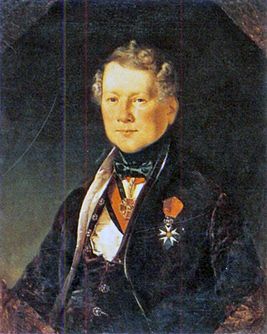

The graphic department of the State Hermitage holds a red and gold embossed folder with drawings, signed: “Various architectural projects presented and dedicated to His Majesty the Emperor of All-Russian Alexander I August Montferrand, a member of the French Academy of Architecture. Paris”. The architect presented his projects to the emperor in 1814, when the Russian troops entered Paris. Already in 1816 Montferrand came to St. Petersburg.
French by birth, Henri Louis Auguste Ricard de Montferrand was born January 23, 1786 in the suburbs of Paris, but his architectural, artistic and construction activities are inextricably linked with Russia.
Having received the post of the senior draftsman of the Committee for Construction and Hydraulic Work, on February 29, 1818, by decree of Emperor Montferrand, the restructuring of St. Isaac’s Cathedral was entrusted. Adhering to the wishes of Alexander I to maximally preserve the existing cathedral, its altar part and the podkupolnye pylons Montferrand leaves unchanged, dismantled the bell tower, altar ledges and the western wall of the cathedral. The building was enlarged in length, and its width remained the same, which made the temple in the plan become rectangular in shape. The height of the vaults did not change either. From the northern and southern sides it was planned to erect colonial porticoes. In 1825, when the construction of the cathedral was already under way, it was decided to modify the building a little. According to the new project of the architect, the cathedral was decorated with four columned porticoes instead of two, the central part was emphasized by a dome square formed by four new supporting pylons, which eliminated the sagging of the dome. At the corners of the main volume were installed four bell towers, as if embedded in walls. Now they were located closer to the central dome than in the previous project. This further strengthened the square construction of the building, and it was in this form that the St. Isaac’s Cathedral survived to this day.
The second main work of Auguste Montferrand is the Alexander Column. This monument, dedicated to the victory of the Russian troops in the Patriotic War of 1812, is harmoniously entered into the established ensemble of the Palace Square. The architect designed a column of granite monolith 26.5 meters high. Standing on a monumental pedestal in the center of the square, a colossal column of dark red Finnish granite is crowned with a Roman-Doric capitol. At the top of the hemisphere is a bronze statue depicting an angel.
Auguste Montferrand died on June 28, 1858. He bequeathed to bury himself in St. Isaac’s Cathedral, but this was not allowed by Emperor Alexander II, since the architect was a Catholic. The coffin with his body was surrounded around St. Isaac’s Cathedral, but the funeral of the architect was held in the church of St. Catherine. The widow of Montferrand took the architect’s body to Paris, where he was buried in the Montmartre cemetery.